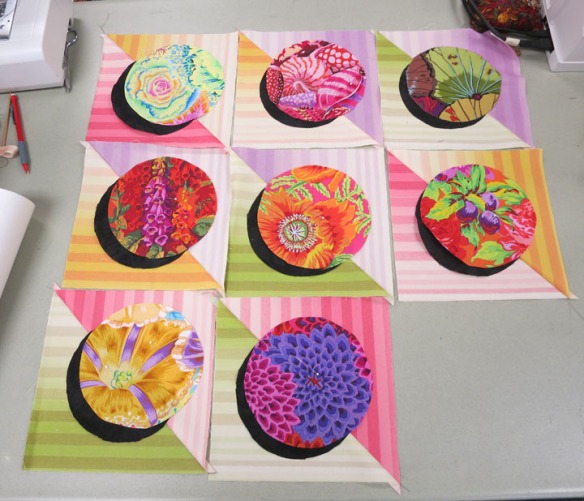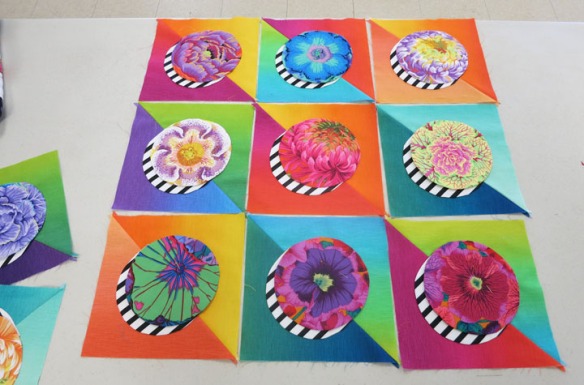by Christine Barnes
The poet Robert Burns wrote in his poem To a Mouse, “The best laid plans of mice and men often go awry.” It’s true for quilters, too, and I am living proof. This is the story of my crooked path to a new plan for a quilt.
By now you know that I adore plaids. I also love triangles, and the best way to create triangle squares is with Thangles, strips of paper that have solid and dashed lines for sewing and trimming. They are magical and so easy to use.
I paired a number of my plaids with Grunge semi-solids and set out to make 8′ finished blocks. I liked the first block a lot—the contrast between the plaid and semi-solid fabric makes the design read. These are just the four “raw” units, not yet joined.
Then, I confess, I neglected to follow my own advice and started pairing fabrics and sewing triangle units like crazy, without auditioning. Big mistake. Most of the resulting units were too blended, too contrasty, or just plain chaotic. Trust me, you don’t want to see them! On the phone with my friend Kari, she said, “You mean you didn’t practice what you preach?” Ouch. Count on a friend to speak the truth.
Chastened a bit, I changed gears and decided to work with my other favorite fabrics, stripes, of which I have many. Below is a shot cotton solid and a yummy woven stripe. I rough-cut the fabric strips 5″ wide and 11½” long. Notice that the stripe is running lengthwise—this is very important.

Enter Thangles for 4″ finished units (the package is on the right, below). I love them for the precision and ease—no more cutting triangles and trying to pin and sew them on the bias. Here’s how to use them:
1. Layer the fabrics with a Thangles strip and pin through all layers. You would normally layer the fabrics right sides together, but because both of my fabrics are woven, it doesn’t matter. You only need a few pins, one at each end, and two perpendicular to each solid diagonal line. Just enough to keep things from moving.
2. Shorten your stitch and sew precisely on the dashed lines. How short is short enough? I put mine down four steps from the default, but you’ll need to experiment to find what’s right for you. Once you sew the first set of strips and start to remove the paper, you’ll know if the stitch needs to be shorter. 
3. Trim the excess fabric along the side edges, the top and bottom, and the center line. 
4. Fold the paper triangles back along the stitching lines, crease them with your thumbnail, and tear the pieces away. Here I’ve folded back just two of the paper triangles. 
5. Tear off all the paper pieces, including the short strips between the stitching lines.
6. Cut the triangles apart between the stitching lines.
7. Press the seam allowances open. I press using a seam roll because it keeps the seam from stretching on the bias and generally makes the process go better and faster. Mine is made by Dritz and was inexpensive. (It’s plaid on the other side.)
8. Voila! You have four 4½” triangles units, which will finish to 4″. I don’t trim the dog ears at this point; I find them helpful when joining the units.
9. Now the magic happens. Because you cut the original striped fabric lengthwise and used Thangles, the stripes are automatically perpendicular to each other. I love seeing how the block looks at this stage. The four units in the image below are not yet sewn together. See how the diagonally opposite triangles relate? They are actually identical.
10. Now back up and sew the top and bottom units together to make two rows. Tip: It’s not necessary to pin through the diagonal seams perfectly. If you sew and trim carefully, things will naturally line up at the outer edges and you’ll have good “points.”
Also, when I join the rows, I pin the outer edges carefully and let what happens at the center intersection just happen. I do not like to “ease” one section in and “stretch” another section out. Life is too short. With stripes, your eye won’t notice any slight misalignment.
11. Join the rows to make a block with “spinning” triangles. I call these a cheap thrill because Thangles do the work for you. And you end up looking sooooo smart.
I now have nine different blocks, and I’ll show you the setting in a future post or newsletter. If you don’t already get “Christine’s Color Connection,” you can sign up on my website Home page or on your smartphone by texting COLOR4Q to 22828.
There’s a bit of snow on the ground this morning. Stay cozy and warm in this “bleak midwinter.” It’s a great season for sewing!

























